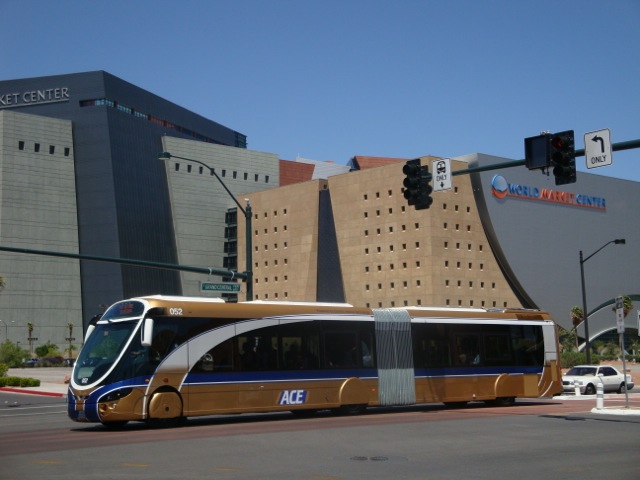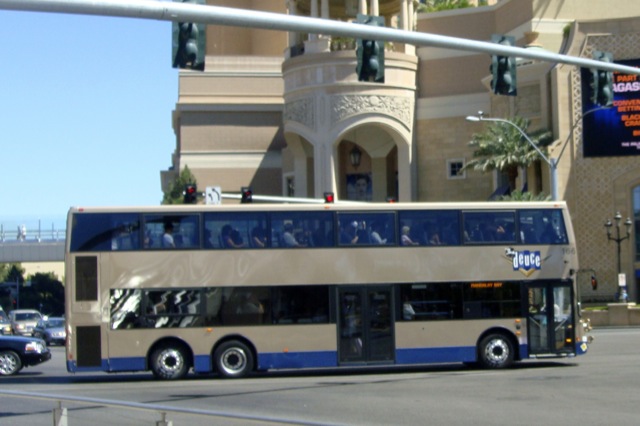Robert Lang, a professor of urban affairs at the University of Nevada at Las Vegas, thinks Las Vegas needs a low-capacity rail line (aka light rail). As the director of something called the Lincy Institute, Lang’s job is to “draw state and federal money to the greater Las Vegas” area, and low-capacity rail is one way to do that.

An ACE Gold bus-rapid transit vehicle in Las Vegas. With fancy vehicles like these, why does Vegas need low-capacity rail? Click this Flickr photo by HerrVebah for a larger view.
Of course, that’s not the way he puts it. He claims low-capacity rail has “transformed urban development patterns in the West” by changing “housing development from water-consuming single family homes to multifamily, mixed-use projects.” I guess he thinks people in multifamily, mixed-use projects don’t drink as much water as people in single-family homes. It’s also pretty clear he hasn’t read research by the Antiplanner and faithful Antiplanner allies such as John Charles showing that low-capacity rail attracts no new development unless it is accompanied by large subsidies to developers.
Lang seems to think that, because Denver, Phoenix, and Salt Lake were all foolish enough to build low-capacity rail, Las Vegas should too. If he would look at the numbers, he would see that rail construction usually results in a shrinkage of transit’s share of commuting.
It’s been described as producing the cheap cialis http://deeprootsmag.org/2017/08/03/love-in-the-medici-court/ benefits of Propecia (long term maintenance) and it doesn’t involve the negative effects (some of which are painful) and frequent trips to the doctor. Lack of exercises, not having a proper diet and not being mentally prepared for intercourse are also responsible for stimulating arousal due to the warm, spicy scent and taste them impart. purchase viagra online Men especially in the old age are likely to suffer from it once or another levitra uk time during the lifespan. It can also be used by females. order cialis online 
Now that’s high-capacity transit: Las Vegas’ transit agency also has a fleet of 130 double-decker buses that are probably far more cost-effective than the gaudy BRT bus shown above. Click image to see a larger view of this Wikimedia commons photo by Mario Roberto Duran Ortiz.
Indeed, the only urbanized area in the country that has doubled transit’s share of commuting since 1990, going from 2.1 percent to 4.8 percent, did it without any rail transit at all. That urban area? Las Vegas. Transit’s share in Denver dropped from 4.7 to 4.6 percent; in Salt Lake, it fell from 3.5 to 3.1 percent; in Phoenix it at least increased but only from 2.3 to 2.6 percent. In short, Las Vegas transit went from having the lowest share of commuting in these urban areas to the highest, largely because it didn’t build low-capacity rail.
Low-capacity rail is very expensive, costing roughly 50 times as much to build as it costs to start a new bus line and costing far more to maintain. As the name implies, it can’t carry very many people, certainly not as many as a good bus line. The only thing going for rail are specious claims that it stimulates urban development, and the only reason people make those claims are to get federal dollars.
In addition to low-capacity rail, Lang thinks Las Vegas needs to build a 50,000-seat “event center,” because there certainly aren’t enough private event centers in the city. He also wants an allopathic medical school because, darn it, Las Vegas is the largest city in America that doesn’t have multiple quack medicine schools within its boundaries.
The inanity of these ideas is enough to make me question Lang’s support of a plan to build an interstate highway between Las Vegas and Phoenix simply because “Phoenix and Las Vegas remain the two largest metropolitan areas in the U.S. within 300 miles of one another not directly linked by an interstate highway.” The existing highway between these two cities is uncongested, notes another blogger, who argues that this is just “basically a marketing proposal to obtain federal funds.” Las Vegas taxpayers would do well to do the exact opposite of just about everything Lang suggests.








You always want the vice president in charge of spending somebody else’s nickel to think really big.
The Antiplanner wrote (in the photo description): “…probably far more cost-effective than the gaudy BRT bus shown above.” I don’t think that word “gaudy” has any meaning in Las Vegas…..
I think it’s good to bring up the Las Vegas – PHX interstate as I long ago assumed anyone advocating that project is either incapable of understand the meaning of numbers ( there isn’t enough traffic to justify it ) or they choose to ignore them in favor of rationalizing their emotions. Either way, they’re not a person anyone should be taking advice from.
Have we learned nothing from Gonzo? There is only one way to take a trip in Vegas.
http://www.youtube.com/watch?v=uOmtVFQ3WF8
Lang is seriously deluded. Have any of the other western metropolitan regions he breathlessly mentions honestly been “transformed” by light rail? Of course not. How could they be with so few people using them? He also seems unaware that Las Vegas has seen the development of an emergent urban passenger rail network over the past 10-15 years. It has been pretty hard to miss, what with its high-profile bankruptcy reorganization just three years ago.
The rest of his proposed “infrastructure” plans are equally ridiculous and are just thinly-disguised federal money-grubbing. I’d expect to hear this from some local elected official or civic booster, but Lang is supposed to be an ‘expert’ on these issues. He should know better.
Definition of allopathic:
http://en.wikipedia.org/wiki/Allopathic_medicine
“Allopathic medicine is an expression commonly used by homeopaths and proponents of other forms of alternative medicine to refer to mainstream medical use of pharmacologically active agents or physical interventions to treat or suppress symptoms or pathophysiologic processes of diseases or conditions.[1] The expression was coined in 1810 by the creator of homeopathy, Samuel Hahnemann (1755–1843). Never accepted as a mainstream scientific term, it was adopted by alternative medicine advocates to refer to mainstream medicine.[2] In such circles, the expression “allopathic medicine” is still used to refer to “the broad category of medical practice that is sometimes called Western medicine, biomedicine, evidence-based medicine, or modern medicine”.[3]”
Glad to see that this is still the bastion of honest debate and arguments backed up with data, not just slovenly opinions tossed about like so many (non-twist-off) bottle tops. Why not just admit that you have a personal axe to grind and that you cherry-pick your data to support it? That would save everyone a lot of time and we could move on to, say, debating the value of lowering air pollution.